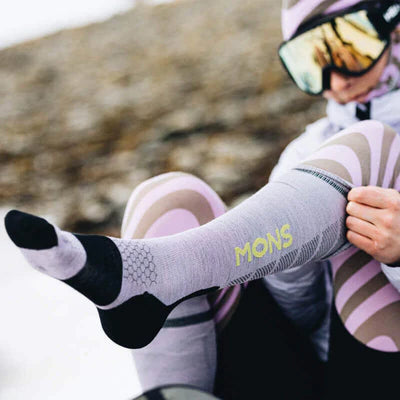Layering is an important trick to master for your outdoor adventures! By learning how to properly layer, it will come in handy as it can make or break your time in the mountains. If you layer correctly, you can stay out for longer, thoroughly enjoy the day, and save some energy.
While your activity may differ, typically the rules of layering work like this.
- A base layer is engineered to move as much moisture from your body outwards, so it doesn’t stay on your skin. You’ll see base layers described as ‘breathable’, ‘quick drying’ or that ‘wick moisture away’ – these are the best options to go for. A good base layer is definitely one of the most important pieces of layering to invest in as it’s going to be directly in contact with your skin. A bad base layer can throw off the work the rest of your layering is doing.
- Mid layer is all about trapping in the warmth from your body heat and keeping it close to your skin. It also is responsible for moving the moisture from your body and base layer outward. Recommended fabrics for the mid layer are synthetic or down jackets, as well as fleece.
- The outer layer is typically a protector from the elements, like wind, rain, or snow. It can sometimes be referred to as a shell and is always your last layer.
Here’s some products to consider for each outdoor activity:
Hiking
Base Layers
Something breathable for the way up, and warm for the way down. Think Icebreaker Zone Knit or the Mons Royale Cascade Merino Flex 200.
Mid-Layer
Technical Merino mid-layer. For example, Icebreaker Quantum 3 Hoodie for temperature regulation! It allows you to stay warm when needed and works very well under your outer layer.
Outer Layer
Perfect to wear on top of those technical base and mid layer, to ensure your fully protected from rain and wind. Check out The North Face Women’s Venture 2 Jacket to protect you on rainy hiking trips.
In-Resort Skiing
Base Layers
For your top, 200 weight is perfect for your everyday. 260 is ideal for those crisper days! For your bottoms, 3/4 length leggings plus ultra-thin sock, as recommended by our trusty boot fitters! This is the perfect pairing because the less that is inside your boot, the better. Wearing ¾ length leggings pairs with ski socks perfectly, leaving no overlap or exposed skin.
Mid-Layer
Technical Merino mid-layer. Something like the Mons’ Arcadia Merino Fleece Hoody, which is perfect to hold heat and stay cosy for the après!
Outer Layer
Insulated jackets work well for sitting on the lifts and cruising down the slopes. Our store has a range of different fits and styles to follow what you’re looking for!
Touring/Slack Country Missions
Layering for these big days is all about ensuring each layer is easy to take off and put back on when required.
Base Layers
Something zone insulated, warm where you need it while also breathable. Suitable for both directions: going up or down
Mid-Layers
Can be multiple. For example, Technical Merino mid-layer, like the Mons Approach Fleece, plus…An insulation layer like the Mons’ Arete Insulated Hoodie, which now includes Pertex for some water protection.
Outer Layer
A Gore-Tex shell will keep you dry and is a great moderator of heat to adapt to any part of the touring mission. Perfect to pair with a shell jacket such as The North Face Ceptor.
Accessories
Neckwarmer/ Balaclavas
Perfect for those cooler days out for adventures, or to wear under your helmet on the slopes!
Technical Socks
Can make or break your day! For the ski days, Think the thinner the better… the less inside your boot, the happier your feet will feel! Our bootfitters’ go to are the SmartWool Ultralight.
Gloves
Merino/Fleece layer…keeps your hands warm and dry in the cold/wet conditions, works perfect under a leather or Gore-Tex glove/mitt.



